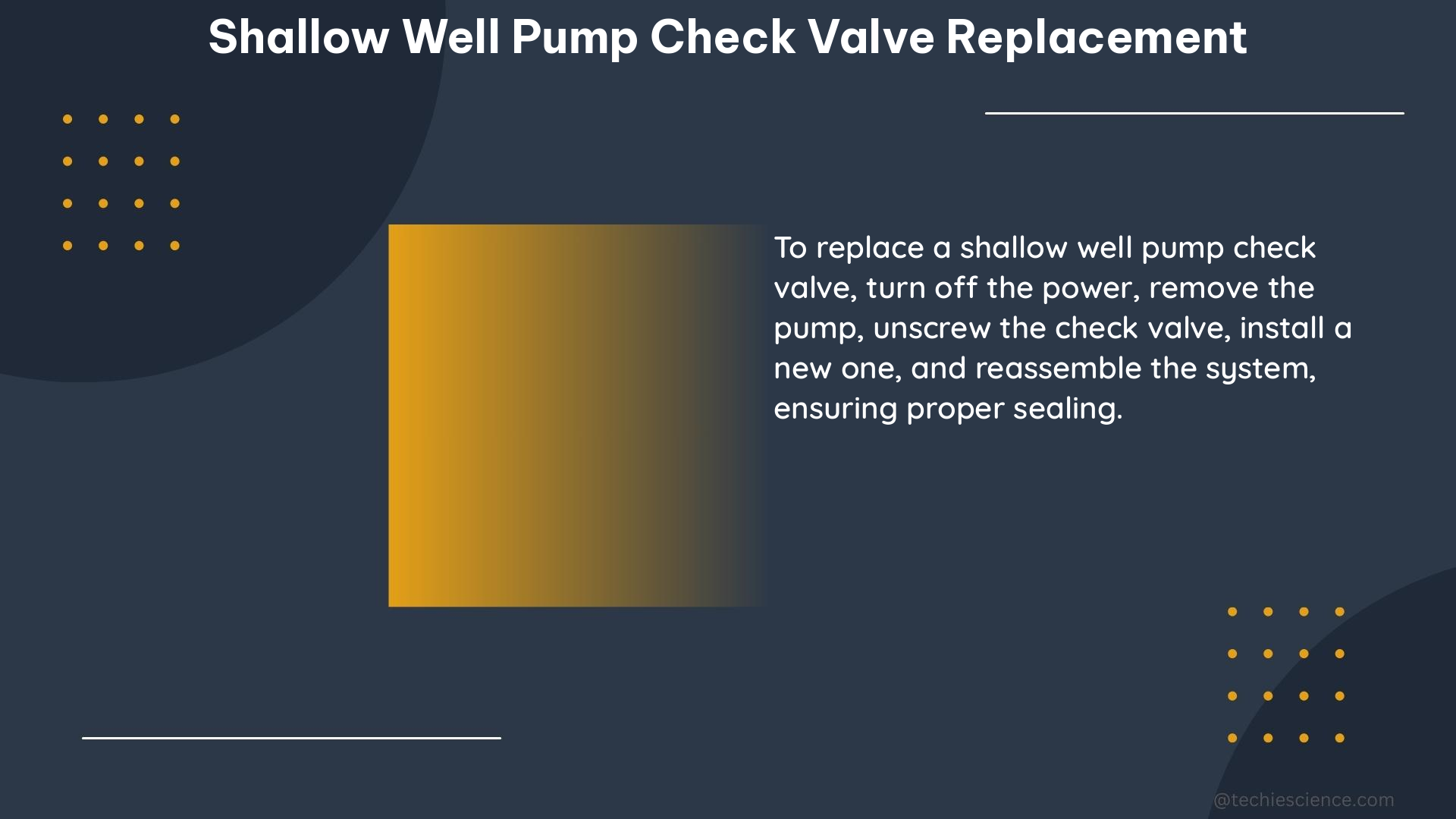Shallow well pump check valves are crucial components in well pump systems, preventing water from flowing back into the well when the pump turns off. These valves come in various materials, including stainless steel, ductile iron, bronze, and PVC, each with its own advantages and disadvantages. Proper selection, installation, and maintenance of these check valves are essential for the efficient and reliable operation of a shallow well pump system.
Selecting the Right Check Valve
When selecting a check valve for a shallow well, several factors must be considered:
-
Pipe Flow Velocity: The pipe flow velocity should not exceed 3 m/s (9.8 ft/s) for optimal service life. Higher velocities can cause erosion and premature wear of the check valve components.
-
System Pressure: The system pressure should be calculated, considering the entire system’s hydraulics, not just the pump’s pressure setting. This ensures the check valve is rated for the maximum pressure the system may encounter.
-
Material Compatibility: The check valve material should be compatible with the water quality and any chemical treatments used in the well system. Stainless steel and bronze are common choices for their corrosion resistance.
-
Valve Size: The check valve size should match the diameter of the well’s discharge pipe to minimize flow restrictions and pressure drops.
-
Valve Type: The check valve type, such as swing, ball, or piston, should be selected based on the specific requirements of the well system and the desired level of flow control.
Preparing for Check Valve Replacement

Before installing a new check valve, it is essential to ensure the following:
-
Valve Condition: Carefully inspect the check valve for any defects, such as cracks, corrosion, or damage to the spring-assisted poppet. Ensure the poppet can move freely.
-
Pipe Preparation: Clean the well discharge pipe thoroughly to remove any debris or scale buildup that could interfere with the check valve’s operation.
-
Pipe Alignment: Ensure the well discharge pipe is properly aligned and supported to prevent stress on the check valve during operation.
Installing the Check Valve
When installing the check valve, follow these steps:
-
Orientation: The arrow on the outside of the valve’s body should face the intended flow direction when the pump operates.
-
Pipe Connections: Use appropriate fittings and sealants to ensure a secure and leak-free connection between the check valve and the well discharge pipe.
-
Support: Provide adequate support for the check valve to prevent stress on the pipe connections and ensure proper alignment.
-
Testing: After installation, test the check valve’s operation by turning the pump on and off, ensuring the valve opens and closes as expected.
Troubleshooting Pressure Loss
A common issue in well pump systems is the pressure tank losing pressure while the pump is not operating. This pressure loss can result in additional costs due to increased power consumption from the well pump cycling more frequently. To troubleshoot this issue:
-
Check Valve Test: Turn off the connection between the pressure tank and what it services, wait about one hour, and check if the tank is still losing pressure. If it is, further investigation is necessary.
-
Potential Causes: The pressure loss may be caused by the check valve, the drop pipe, or buried pipes in the system. Carefully inspect each component for any issues.
-
Replacement: If the check valve is found to be the cause of the pressure loss, it should be replaced with a new, properly functioning valve.
Replacing a Submersible Pump’s Check Valve
Replacing the built-in check valve of a submersible pump requires lifting the pump out of the well. Follow these steps:
-
Pump Removal: Carefully remove the submersible pump from the well, following the manufacturer’s instructions.
-
Check Valve Removal: Locate and remove the existing check valve, taking note of its orientation and any seals or gaskets.
-
Check Valve Replacement: Install the new check valve, ensuring it is the same model and that any seals or gaskets are replaced as well.
-
Manufacturer Guidance: Contact the pump manufacturer for any specific instructions or recommendations regarding the check valve replacement process.
-
Reinstallation: Carefully reinstall the submersible pump back into the well, ensuring proper alignment and connections.
By following these comprehensive guidelines, you can effectively replace the check valve in a shallow well pump system, ensuring optimal performance, energy efficiency, and long-term reliability.
References:
- Check valve on well pump | DIY Home Improvement Forum
- Question about shallow well pumps and check valves : r/Plumbing
- Well Pump Issues – check valve failure and low pressure
- Well Pump Check Valve | Tameson.com

The lambdageeks.com Core SME Team is a group of experienced subject matter experts from diverse scientific and technical fields including Physics, Chemistry, Technology,Electronics & Electrical Engineering, Automotive, Mechanical Engineering. Our team collaborates to create high-quality, well-researched articles on a wide range of science and technology topics for the lambdageeks.com website.
All Our Senior SME are having more than 7 Years of experience in the respective fields . They are either Working Industry Professionals or assocaited With different Universities. Refer Our Authors Page to get to know About our Core SMEs.